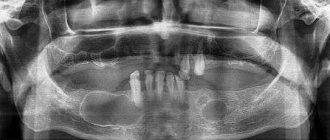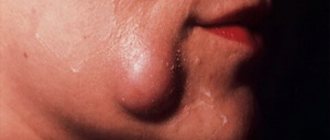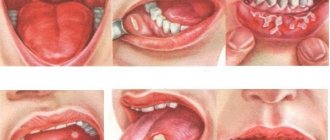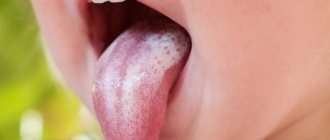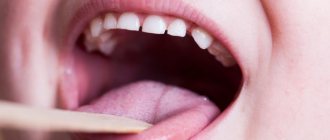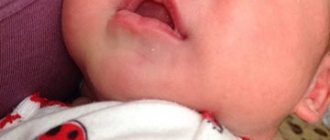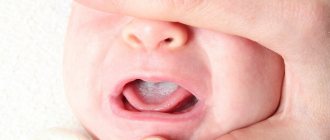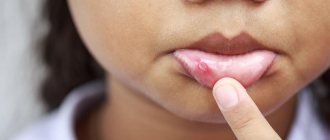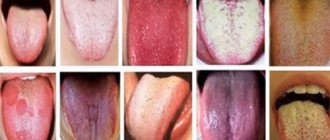Causes
Stomatitis is a disease that affects the mucous surfaces of the oral cavity. This is an acute inflammatory process of various etiologies, which is manifested by the appearance of yellowish or whitish pimples with liquid and ulcers. It can occur in children and adults, but children are much more likely to suffer from the disease.
The rash affects the inside of the cheeks, gums, and tongue. Their appearance causes discomfort, since ulcerative wounds itch, hurt, and there is a constant burning sensation in the mouth.
Young children have extremely delicate oral mucous membranes. The body’s insufficiently developed defense system is not able to quickly cope with infectious agents, so the natural reaction of the immune system to their entry into the body is inflammation. Common causes of the disease are:
- insufficient oral hygiene;
- chronic gastrointestinal diseases;
- mucosal injuries;
- burn;
- ingestion of pathogenic bacteria from hands or toys.
Important! Treatment of stomatitis in children is possible at home. However, in order to choose the right treatment regimen, you cannot do without consulting a specialist.
Symptoms of herpes on the lips in children
How does herpes appear on the lips of a child? Depending on the stage of the disease, manifestations will vary. Common symptoms at first are fever, feeling tired, aches, and irritability. Before a rash appears on the skin, it usually feels itchy, tingling, and painful. Over time, the rash can develop into ulcers and wounds; the child often scratches them until they bleed due to itching. This prolongs the healing process. If the herpes is uncomplicated, localized, then such herpes on the lips of children does not require treatment. It will pass in 1-2 days or last a little longer, but without any discomfort for the child.
Other symptoms of the disease: mouth ulcers, swelling and bleeding of the gums, enlarged lymph nodes. Damage to the mucous membrane of the throat with the formation of ulcers may also occur. In this case, the small patient should not be given solid or hot food, otherwise the healing process will be significantly delayed (2 weeks or more).
Kinds
Today, 8 types of stomatitis can be diagnosed:
- bacterial;
- aphthous - manifests itself when immunity decreases due to gastrointestinal diseases and anemia;
- herpetic – occurs due to the herpes virus;
- viral;
- angular;
- allergic – a reaction to an allergen entering the child’s body;
- traumatic - the cause may be an accidental bite of the lip with teeth or scratches on the gum;
- fungal – infection of the oral cavity by fungi of the genus Candida.
All types of stomatitis can occur in childhood. However, from birth to 3 years, children are especially susceptible to aphthous, candidal, herpetic and allergic types. During the period of active growth of baby teeth, traumatic stomatitis often appears, caused by rupture of the soft tissue of the gums.
Note! Stomatitis does not always occur on its own. Quite often, rashes in the mouth are a sign of other diseases, so before treatment it is necessary to carry out a series of diagnostic measures to discover the exact cause.
Symptoms
The classic clinical picture for diagnosing stomatitis includes the following symptoms:
- swelling of the mucous membrane;
- the appearance of a white or yellowish coating;
- bad breath;
- dryness or excessive salivation;
- enlarged lymph nodes and increased temperature.
Stomatitis in children has similar and different symptoms. Each type of disease has its own differences in manifestations.
With allergic stomatitis, minor ulcerative lesions appear on the palate, gums, cheeks, and lips. They pass as soon as the irritant can be identified and removed. With aphthous, even one spot with a diameter of up to 1 cm may appear in the mouth. Its outer part is covered with a film, the ulcer is yellow, and its edges are inflamed. If stomatitis is herpetic, then the mucous membrane is affected by numerous rashes that merge into one large wound. These are blisters with clear liquid and are extremely painful. Often the herpes virus causes a deterioration in the general condition of the child’s body, accompanied by body aches and high fever.
The most common type of stomatitis in a child’s mouth is candidiasis. Its common name is thrush. 9 out of 10 parents have encountered this phenomenon at least once. It is characterized by the appearance of a white cheesy coating on the tongue, gums, and cheeks of the baby. It is often observed after completing a course of antibacterial therapy or as a consequence of infection of the mother’s nipples by Candida fungus. Candidiasis can also be caused by poor hygiene.
On a note! Regardless of the type of stomatitis, its treatment should be comprehensive and begin immediately after the first signs of damage to the oral cavity are detected!
Treatment options
How to cure stomatitis in a child? It’s worth noting right away that you can’t prescribe medications to your baby yourself. Only the pediatrician makes a diagnosis and makes recommendations for therapy. Attempts to overcome the disease on your own can lead to a worsening of the little patient’s condition. To determine the causative agent of the inflammatory process, a scraping is made and a virological study is carried out.
For stomatitis in children, what treatment will be most effective? Only those therapeutic measures will help that will affect the disease comprehensively, eliminating both the cause and external manifestations.
Medicines
When an accurate diagnosis is established, dentists prescribe medications for the treatment of stomatitis in children. They are conventionally divided into symptomatic and special.
The purpose of the first is to eliminate the symptoms that accompany the disease. For this purpose the following is prescribed:
- vitamin complexes to strengthen the body;
- antiviral drugs that fight viruses;
- antipyretic and anti-inflammatory drugs;
- anesthetic gels;
- ointments and solutions for treating the oral cavity.
- need to drink plenty of fluids
- gentle diet (exclude sour, salty, spicy)
Candidal stomatitis is treated with special pharmaceuticals that contain substances that kill the fungus. Creams suitable for internal use are prescribed. If an allergic type is detected, the pediatrician will add antihistamine drops or tablets to the general list. If the rash is caused by the herpes virus, you cannot do without taking antiviral drugs, as well as local treatment of the mucous membranes with antiherpetic ointment.
Attention! The entire oral cavity needs to be treated, since pathogens are found everywhere on the mucous membrane. They are not visible to the naked eye, but if they remain in the mouth, they will continue to spread and the treatment will be delayed.
Folk remedies
Have you noticed stomatitis in a child and don’t know how to treat it? Drug therapy can be supplemented with the use of traditional medicine. Compositions prepared from natural ingredients are used to treat stomatitis in children over 2 years of age.
The following formulations are suitable for treating mouth ulcers.
Soda and salt
0.5 tsp each Dissolve the components in warm water. Rinse your mouth with the solution 3-4 times a day after meals. Baking soda relieves inflammation and disinfects well. The same composition, only diluted with water to a mushy consistency, can be used to clean off plaque from fungal stomatitis using a finger wrapped in gauze.
Honey and aloe
The leaf of the plant is ground to a puree, and the same amount of natural honey is added to it. Apply to affected areas three times a day.
Chamomile with honey
Dried flowers are brewed in the proportion of 1 tbsp. for 250 ml of boiling water. Add 2 tsp to the cooled broth. honey Rinse your mouth with warm liquid 2-3 times a day.
Rinses can be prepared from other ingredients:
- sage;
- rosehip;
- St. John's wort;
- oak bark;
- flaxseeds;
- yarrow;
- calendula;
- propolis tinctures.
Lotions of essential oils help a lot.
Important! Folk remedies can only be used after consulting a pediatrician!
How to prevent stomatitis
To reduce the risk of getting an infection in your mouth, you should:
- regularly wash toys, hands, pacifiers, bottles;
- carry out wet cleaning and ventilate the room where the baby spends his leisure time;
- strengthen the immune system: strengthen the child, give vitamins, maintain proper sleep and wakefulness;
- provide a balanced diet;
- fight the bad habit of biting nails or other objects (pencils, pens, rulers);
- Make an appointment with the dentist twice a year for a routine examination.
Any disease should be treated in a timely manner, otherwise negative consequences cannot be avoided. Carefully examine the child’s oral cavity at the first complaints. When stomatitis occurs in infants, the first symptoms include behavioral changes, crying, and refusal of the breast or bottle. Children aged 1 year and older will be able to independently point out to their parents the source of discomfort. Get treated promptly and be healthy!
When to see a doctor
Symptoms of the virus may be typical or atypical. Regular herpes on the lips of a child will go away on its own in a few weeks or a little later. However, even with an uncomplicated disease, it is better to consult a specialist. This will help relieve the baby’s discomfort; antiviral drugs will be prescribed for external and internal use. These medications will reduce the intensity and duration of the first stages of the disease. Manifestations of common herpes include blisters on the lips (gums). There may also be a fever, severe sore throat and enlarged tonsils.
You should immediately show your child to a specialist if atypical manifestations of herpes appear. They are as follows:
- The baby developed a rash or sores and a strong fever. Such signs indicate the manifestation of a chronic infectious herpes simplex virus;
- rashes around the eyes. The disease often provokes inflammation of the cornea;
- headache, convulsions, increased body temperature, loss of orientation in space. In this case, there may be a manifestation of cerebral infections provoked by the herpes virus.
When answering the question of what to do if a child has herpes on the lip, we advise you to contact a dermatovenerologist or pediatrician. You can make an appointment with these specialists without leaving your home. This can be done on our website. JSC "Medicine" (clinic of academician Roitberg) is located in the central district of the capital.
How to make an appointment with a pediatrician, dermatovenerologist, immunologist-infectious disease specialist
You can make an appointment with specialists from JSC “Medicine” (clinic of Academician Roitberg) on the website or by calling +7(495)995-00-33. The clinic is located in the Central Administrative District of the capital. If there are symptoms of herpes on the lips of a child, contact experienced specialists. For diagnostics, our clinic uses modern innovative equipment of the latest generation.
As soon as the first signs of the disease appear, do not delay visiting a doctor. Get advice from experienced doctors at JSC “Medicine” (clinic of academician Roitberg). You will be prescribed an individual course of treatment and your child will be monitored throughout it until complete recovery.
